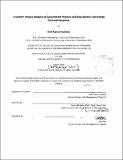| dc.contributor.advisor | Henry Birdseye Weil. | en_US |
| dc.contributor.author | Gadhok, Neil, 1978- | en_US |
| dc.contributor.other | Massachusetts Institute of Technology. Engineering Systems Division. | en_US |
| dc.date.accessioned | 2013-07-10T14:50:19Z | |
| dc.date.available | 2013-07-10T14:50:19Z | |
| dc.date.copyright | 2012 | en_US |
| dc.date.issued | 2012 | en_US |
| dc.identifier.uri | http://hdl.handle.net/1721.1/79506 | |
| dc.description | Thesis (S.M.)--Massachusetts Institute of Technology, Engineering Systems Division, 2012. | en_US |
| dc.description | Cataloged from PDF version of thesis. | en_US |
| dc.description | Includes bibliographical references (p. 42-43). | en_US |
| dc.description.abstract | A vision of distributed energy generation, storage, electric vehicles and a "smart-grid" has been the driving force of a number of regulations and policies to promote a steady evolution of the existing & future infrastructure relating to the generation, transmission, distribution and retailing of electrical energy. Demand Response (DR) is often cited for smoothing this evolution as it has the ability to shave peaks and provide flexibility in load to dynamically adapt to an increasingly variable supply from renewable energy resources. In general, there are regulations and policies which are inadvertently increasing supply volatility (e.g., wind & solar). There are regulations and policies increasing technology adoption to decrease supply volatility (e.g., storage). There are regulations and policies which are inadvertently increasing demand volatility (e.g., electric vehicles). Finally, there are regulations and policies to increase technology adoption to decrease demand volatility (e.g., demand response). While the individual regulations are well-intentioned, from a holistic point-of-view, it is unclear how the combination of these government regulations will influence the electricity industry. The approach to answer this question is the creation of a System Dynamics Model of the Electricity industry highlighting demand response, energy efficiency initiatives, electric vehicles, storage, and variable energy resources and associated regulatory levers. The model was used to analyze the impact of regulations on the medium to long term dynamics of the industry. The result is a hypothesis that there will be a need for extra government incentives to increase the adoption of distributed generation, storage and demand response to align with the forecasted adoption rate of variable energy resources and electric vehicles in order to maintain grid reliability. | en_US |
| dc.description.statementofresponsibility | by Neil Kamal Gadhok. | en_US |
| dc.format.extent | 49 p. | en_US |
| dc.language.iso | eng | en_US |
| dc.publisher | Massachusetts Institute of Technology | en_US |
| dc.rights | M.I.T. theses are protected by
copyright. They may be viewed from this source for any purpose, but
reproduction or distribution in any format is prohibited without written
permission. See provided URL for inquiries about permission. | en_US |
| dc.rights.uri | http://dspace.mit.edu/handle/1721.1/7582 | en_US |
| dc.subject | Engineering Systems Division. | en_US |
| dc.title | A system impact analysis of government policies and regulations concerning demand response | en_US |
| dc.title.alternative | Government regulations on demand response | en_US |
| dc.type | Thesis | en_US |
| dc.description.degree | S.M. | en_US |
| dc.contributor.department | Massachusetts Institute of Technology. Engineering Systems Division | |
| dc.identifier.oclc | 849742026 | en_US |
